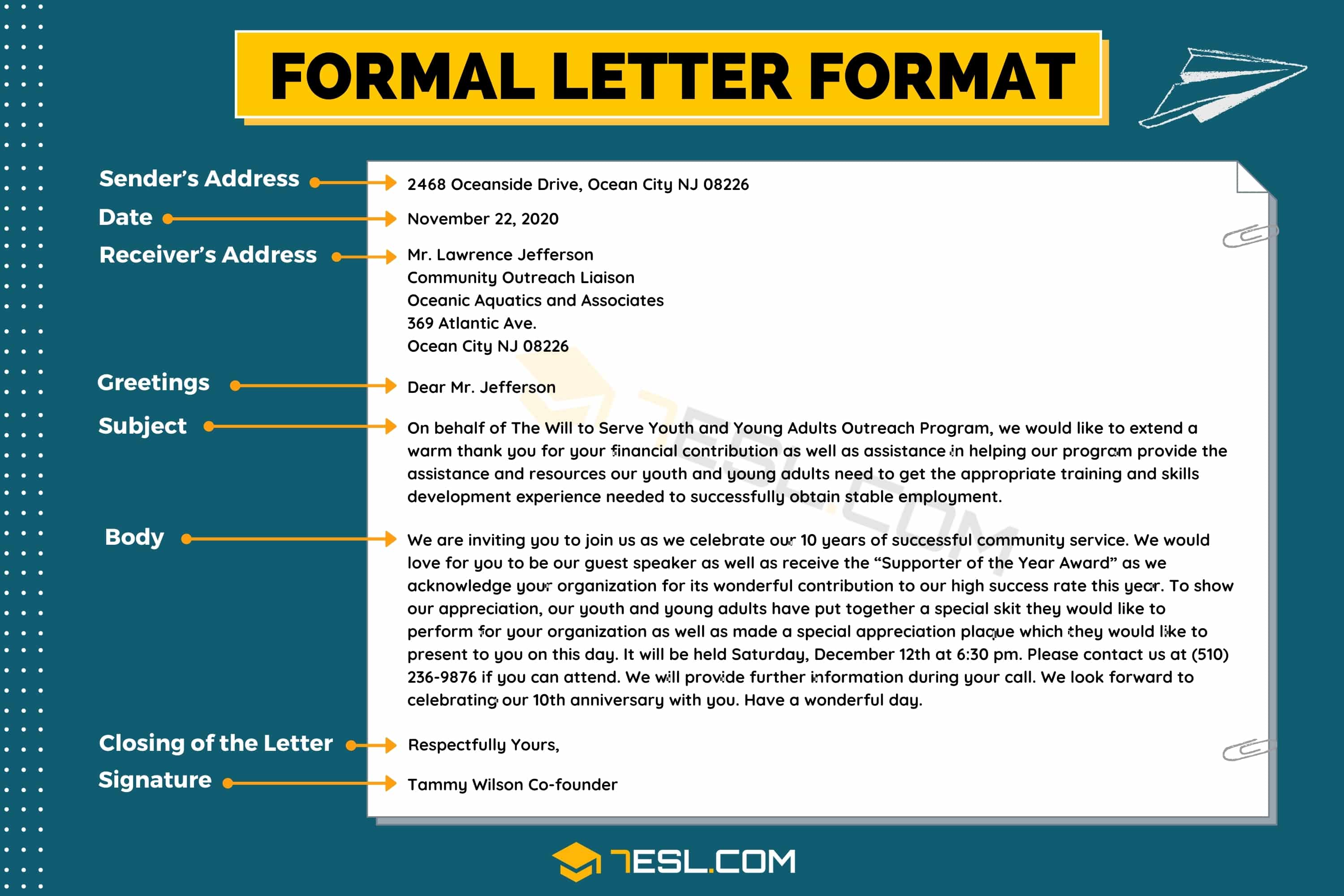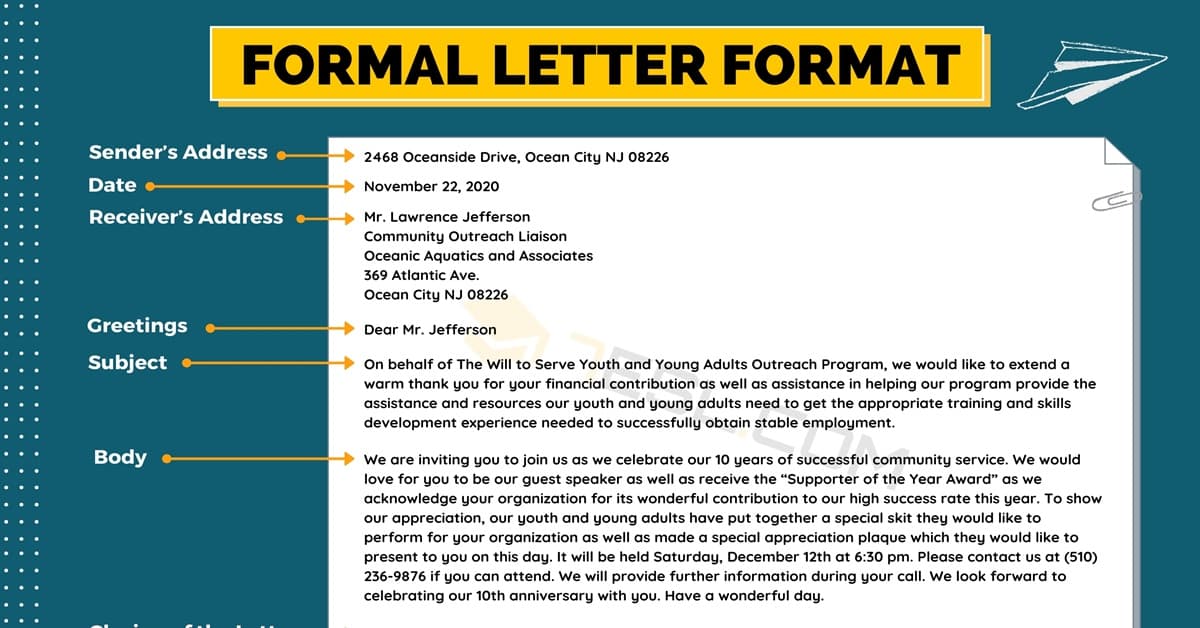Formal Letter Format! A formal letter, otherwise known as an “official” letter, is an officially written document written to another business or individual professional. They are most commonly used when making a formal inquiry, filing a complaint, or expressing interest in employment. It is the first and last contact that you make with the prospective employer. This letter should be well planned out and contain a convincing and polite manner to convey your need for the job.
What is A Formal Letter?
A formal letter is a letter between two entities, organizations, or private parties, either within an industry or within a specific market segment. The general style of letters usually depends on the level of interaction between the parties involved. A formal letter should be presented in a manner that makes the reader feel as if he or she is reading a professional document. In most cases, a formal letter should be prepared by someone who holds the authority to do so.
A typical formal letter might contain a list of the reasons why the parties would like to do business with one another, include a brief description of their company and products, and provide a copy of their business license and registration documents. The formal letter must also be well-organized and formatted.
Formal letters are usually given in public settings, such as at the office, at the trade show, at the airport, at the dinner table, and the church. This is because formal letters must be addressed to people that are familiar with business transactions. These types of letters, for instance, maybe informal, but they still need to be written to a recipient that has some knowledge of business relationships and etiquette.
When writing a formal letter, you are not allowed to send a letter to any other parties. The only acceptable letters are those that are addressed to people who are involved in the transaction or have some level of knowledge of business relationships. If the other parties to the transaction do not know who you are and your letter is received, they may think you are looking to take advantage of them.
Formal Letter Format
The formal letter format commonly known as a business letter is generally referred to as an executive letter or the corporate letter. Corporate letters are often more formal than personal letters, especially in some ways: They have more of an official tone. The head of the letter, which usually starts with the name of the person who sent it, is called the cover letter and may be accompanied by additional information like a biography or the company’s mission. The cover letter often contains basic information about the recipient, such as his/her address, date of birth, and job objective. It also includes a formal job description, salary, benefits, and other employment information.
Many companies use formal letter formats to provide their executives with the information needed for a new position. While the executive may send his letter by mail or by email, many online companies provide their clients with personalized business letter templates. For example, some companies offer their clientele the option of choosing from an array of letter templates to get started on a new career. Some of these include resume writing templates, business cards, business greeting cards, letterhead, invitation cards, and much more. Each template has its own specific format for formatting letters, but many of them follow the same general principles.
So, if you are looking for a way to show your business skills and credentials to the appropriate people, a personalized business formal letter format template can be the perfect way to do so.
Formal Letter Example
- Sender’s Address
2468 Oceanside Drive
Ocean City NJ 08226
- Date
November 22, 2020
- Receiver’s Address
Mr. Lawrence Jefferson
Community Outreach Liaison
Oceanic Aquatics and Associates
369 Atlantic Ave.
Ocean City NJ 08226
- Greetings
Dear Mr. Jefferson
- Subject
On behalf of The Will to Serve Youth and Young Adults Outreach Program, we would like to extend a warm thank you for your financial contribution as well as assistance in helping our program provide the assistance and resources our youth and young adults need to get the appropriate training and skills development experience needed to successfully obtain stable employment.
- Body
We are inviting you to join us as we celebrate our 10 years of successful community service. We would love for you to be our guest speaker as well as receive the “Supporter of the Year Award” as we acknowledge your organization for its wonderful contribution to our high success rate this year. To show our appreciation, our youth and young adults have put together a special skit they would like to perform for your organization as well as made a special appreciation plaque which they would like to present to you on this day.
It will be held Saturday, December 12th at 6:30 pm. Please contact us at (510) 236-9876 if you can attend. We will provide further information during your call. We look forward to celebrating our 10th anniversary with you. Have a wonderful day.
- Closing of the Letter
Respectfully Yours,
- Signature
Tammy Wilson Co-founder
How to Write a Formal Letter?
If you are looking to hire someone for a certain position or job, writing a formal letter may just help the hiring company to find you. To make sure that your letter is written well, it is wise to follow these tips. First, set up your letter with your letterhead and address. In addition, make sure that you include your name and address in the “To” portion of your letter.
Second, prepare a detailed outline of your experience, skills, and qualifications to provide a convincing introduction of yourself to the reader. Third, write your opening and closing body paragraphs. Lastly, create your signature and salutation at the end of your letter. Following these simple guidelines will help you write a formal letter that impresses the prospective employer.
Most formal letters begin by giving a short introduction about the company and providing basic information about the recipient, followed by a description of the purpose of the letter. An introductory paragraph usually begins with the name of the recipient (or the name of the company if the recipient is an entity), the address of the recipient, and a date. The rest of the letter follows the introduction. In the body, the writer briefly describes the main idea of the letter, then lists the key points of the message, including what it is meant to accomplish, why the main point is important, and what you hope others will take away from it.
Finally, the closing paragraph briefly summarizes the entire letter and encourages recipients to take whatever steps they need to further their careers. It ends with your signature and a thank you note.
- Learn more about how to write a letter in English.
Formal Letter Format | Image







0 Comments